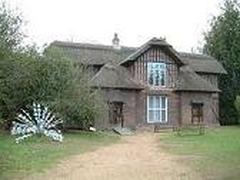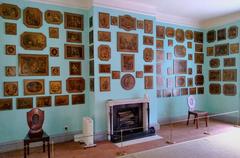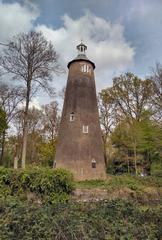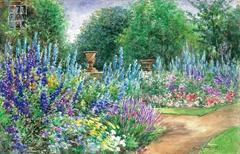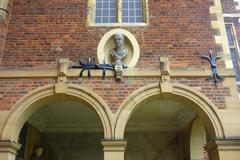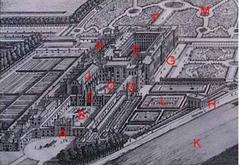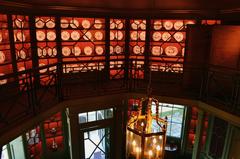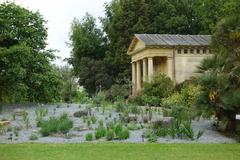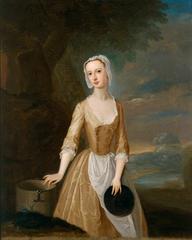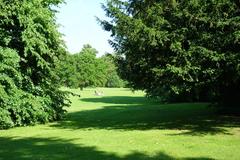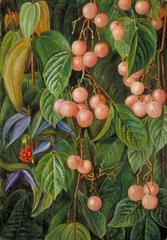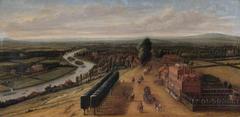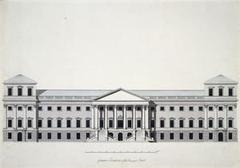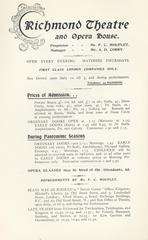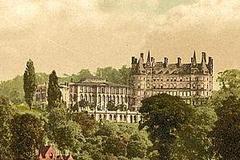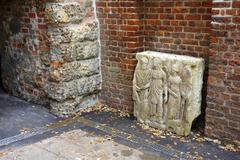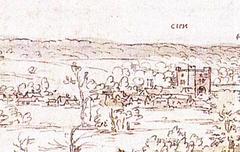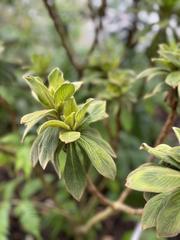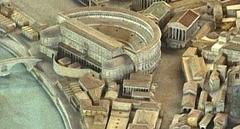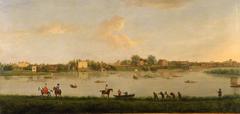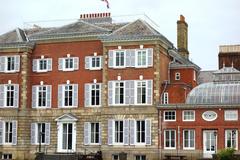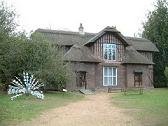
Queen Charlotte’s Cottage, Richmond: Visiting Hours, Tickets, and Historical Significance
Date: 03/07/2025
Introduction
Nestled within the peaceful woodland of the Royal Botanic Gardens, Kew, Queen Charlotte’s Cottage stands as a rare and charming example of 18th-century royal retreat architecture. Built in 1772 for Queen Charlotte, wife of King George III, this thatched cottage orné offers a unique window into the private life of the Georgian monarchy. Visitors today can explore not only the cottage’s picturesque setting and fascinating history but also enjoy the surrounding natural beauty, making it one of Richmond’s must-see historical sites.
This comprehensive guide covers everything you need to plan your visit: historical background, cultural significance, architectural highlights, practical visitor information including opening hours, ticketing, accessibility, travel tips, and suggestions for nearby attractions. For the latest details, always refer to the official Kew Gardens website and Historic Royal Palaces platforms.
Historical Background
Origins and Royal Patronage
Commissioned by Queen Charlotte in 1772, this cottage was conceived as an informal retreat for the royal family within Kew Gardens. Inspired by her North German heritage and the romantic ideals of the period, Queen Charlotte sought a peaceful escape from court life. The cottage’s rustic, timber-framed design reflects the Queen’s personal taste and the wider 18th-century fascination with nature and picturesque landscapes (Historic Royal Palaces).
Architectural Design and Construction
Attributed to architect Sir William Chambers, though possibly designed with Queen Charlotte’s input, the cottage exemplifies the “cottage orné” style. Key features include a thatched roof made from Norfolk reed, exposed timber framing, brick infill, and leaded casement windows. The original single-storey structure was expanded in 1805 with a second floor decorated by Princess Elizabeth, showcasing hand-painted botanical motifs (Historic Royal Palaces, Regency History).
A Royal Retreat and Menagerie
The cottage provided a setting for informal family gatherings, teas, and royal picnics. Its paddock became home to England’s first kangaroos and other exotic animals, reflecting the royal family’s interest in natural history and the wider reach of the British Empire (Kew Gardens Surprising Historical Facts).
Later Use and Preservation
Following Queen Charlotte’s death in 1818, the cottage saw less frequent royal use but remained part of Kew’s landscape. In 1898, Queen Victoria gifted the cottage and surrounding “wilderness” to the public, ensuring its preservation. Today, it is managed by Historic Royal Palaces and holds Grade II* listed status for its architectural and historic significance.
Architectural Features and Style
Design and Interior
Queen Charlotte’s Cottage’s two-storey, timber-framed structure features a thatched roof and striking asymmetry, distinguishing it from more formal Georgian buildings. Interiors are modest, with exposed beams, simple fireplaces, and painted floral decorations. The ground floor houses the Print Room and Picnic Room, both furnished with period pieces, while the upper floor (closed to the public for conservation) was used by the royal family for rest and relaxation (WhichMuseum).
Influence and Legacy
The cottage orné style embodied by Queen Charlotte’s Cottage influenced later movements like the Queen Anne Revival and Arts & Crafts, inspiring architects such as Norman Shaw and Philip Webb. Its use of natural materials and picturesque design reflects the era’s evolving approach to architecture and royal lifestyle (Wikipedia: Queen Anne Revival).
Cultural Significance
Private Royal Life
More than a decorative retreat, Queen Charlotte’s Cottage reveals the private, family-oriented side of the Georgian monarchy. It was a cherished space for informal gatherings, away from the pressures of court. The royal family’s menagerie—featuring black swans, kangaroos, and rare birds—underscored their interest in natural history and global exploration (MyLondon).
Preservation and Public Access
Since opening to the public in 1898, the cottage has offered insight into both royal history and changing attitudes toward heritage preservation. Managed by Historic Royal Palaces, it is now accessible to visitors during Kew Gardens’ open season (Historic Royal Palaces).
Popular Culture
Queen Charlotte’s Cottage has featured in modern adaptations such as Netflix’s “Bridgerton” and its spin-off “Queen Charlotte: A Bridgerton Story,” renewing public interest in this romantic and historic site (MyLondon).
Visitor Information
Opening Hours and Admission
- Seasonal Opening: The cottage is open seasonally, usually from late March to late September, on weekends and bank holidays from 11:00 am to 4:00 pm. These hours can vary, so always consult the official Kew Gardens website for current information.
- Tickets: Entry to the cottage is included with your Kew Gardens admission; no separate ticket is required (Kew Gardens ticketing page).
- Advance Booking: Recommended during peak seasons, weekends, and special events.
Accessibility
- The approach to the cottage involves gravel and woodland paths, which may be uneven or muddy.
- The entrance has a small step, and interiors have narrow doorways and low ceilings—wheelchair access is limited.
- Most of Kew Gardens is accessible, with paved paths and accessible restrooms; check the Kew Gardens accessibility guide for details.
Getting There
- By Public Transport: Kew Gardens station (District Line and London Overground) is a 5–10 minute walk to the main entrance. Kew Bridge (National Rail) is also nearby.
- By Car: Parking is limited and metered; public transport is recommended.
- On Foot: Queen Charlotte’s Cottage is a 20–30 minute walk through the gardens from the main entrance. Wayfinding maps are available at entrances and via the Kew Gardens app (Lonely Planet).
Facilities
- Restrooms and Refreshments: Available elsewhere in Kew Gardens, not at the cottage itself.
- Picnicking: Permitted in the Natural Area, but not inside the cottage or its immediate gardens.
- Gift Shops: The main Kew Gardens shop offers books and souvenirs related to royal history.
Photography
- Photography is allowed for personal use inside and outside the cottage, but no tripods or flash photography are permitted indoors to protect delicate interiors.
Guided Tours and Special Events
- Guided tours and costumed interpretation are occasionally available; check the Kew Gardens events calendar or inquire at the entrance.
- Special exhibitions may enhance your experience, such as displays connected to popular culture or historic artifacts.
Visitor Experience and Seasonal Highlights
The Approach and Setting
The walk to Queen Charlotte’s Cottage leads through Kew’s “Natural Area”—a 37-acre wilderness left intentionally uncultivated since Queen Victoria’s 1898 bequest (Kew Gardens Surprising Historical Facts). In late April and early May, the area is famed for its breathtaking bluebell carpets.
Inside the Cottage
Visitors can view the ground floor rooms, interpreted with period furnishings and botanical artwork. The upper floor is closed to the public for conservation.
The Grounds
The enclosed garden and adjacent paddock once housed exotic animals and are now tranquil open spaces for wildlife and birdwatching.
Family Experience
Children will enjoy the cottage’s storybook appearance and tales of royal picnics and exotic animals. Supervision is recommended due to the fragile interiors.
Visitor Numbers
While Kew Gardens welcomes nearly 2 million visitors annually, Queen Charlotte’s Cottage remains a quiet and contemplative spot, especially outside peak bluebell season (ArtDistance Local Guide).
Travel Tips and Nearby Attractions
- Combine Visits: Pair the cottage with Kew Palace, the Great Pagoda, or the Japanese Landscape for a full day in Kew Gardens (ArtDistance Local Guide).
- Explore Richmond: The town center, Richmond Park, and Ham House offer further historical and scenic experiences (Things to Do in London, Secret LDN).
- Dress Comfortably: Paths may be muddy; sturdy shoes are recommended.
- Plan for Facilities: Restrooms and cafés are found in central areas of Kew Gardens.
Frequently Asked Questions (FAQ)
Q: What are Queen Charlotte’s Cottage opening hours?
A: Typically weekends and bank holidays from late March to late September, 11:00 am–4:00 pm. Always check the official Kew Gardens website for current hours.
Q: Is there a separate admission fee?
A: No, entry is included with your Kew Gardens ticket.
Q: Is the cottage wheelchair accessible?
A: Access is limited due to historic architecture; check Kew Gardens accessibility for details.
Q: Are guided tours available?
A: Occasionally, as part of Kew Gardens’ events program; check the events calendar.
Q: Are pets allowed?
A: Only assistance dogs are permitted in Kew Gardens and the cottage.
Insider Tips for Your Visit
- Time your visit for late April or early May to see the bluebells.
- Download the Kew Gardens app or pick up a map for easy navigation.
- Visit on a weekday for a quieter experience.
- Respect photography guidelines and avoid touching historic furnishings.
- Combine your trip with other Richmond attractions for a full day of exploration.
Conclusion
Queen Charlotte’s Cottage is a peaceful and evocative window into royal history, blending architectural beauty with the tranquility of Kew’s woodland. Whether you are a history enthusiast, nature lover, or simply looking for a unique experience in Richmond, this hidden gem is well worth your time. For the most up-to-date visiting hours, ticketing, and events, always consult the official Kew Gardens website.
Enhance your visit by downloading the Audiala app for audio guides, insider tips, and more. Stay connected for the latest updates, and explore Richmond’s other historical treasures for a full appreciation of the area’s royal and cultural heritage.
Sources and Further Reading
- Visiting Queen Charlotte’s Cottage in Richmond: Hours, Tickets & History, 2025, Historic Royal Palaces (https://www.hrp.org.uk/kew-palace/whats-on/queen-charlottes-cottage/)
- Queen Charlotte’s Cottage Visiting Hours, Tickets & History | Richmond Historical Sites, 2025, Richmond Historical Resources (https://www.hrp.org.uk/kew-palace/history-and-stories/the-story-of-kew-palace/)
- Queen Charlotte’s Cottage Visiting Hours, Tickets, and Tips for Exploring Richmond’s Historic Site, 2025, Kew Gardens Official (https://www.kew.org/kew-gardens/attractions/queen-charlottes-cottage)
- Visiting Queen Charlotte’s Cottage: Hours, Tickets & Tips for Exploring Richmond’s Historic Site, 2025, Kew Gardens and Tourism Guides (https://www.kew.org/)
- Kew Gardens Seasonal Wonders 2025, 2025, Kew Gardens (https://www.kew.org/about/kew-seasonal-wonders-2025)
- Bridgerton and Queen Charlotte’s Cottage, 2023, MyLondon (https://www.mylondon.news/news/tv/bridgerton-real-queen-charlottes-pretty-25221337)
- Kew Gardens Surprising Historical Facts, 2025, Kew Gardens (https://www.kew.org/read-and-watch/kew-gardens-surprising-historical-facts)
- Queen Anne Revival Architecture, 2025, Wikipedia (https://en.wikipedia.org/wiki/Queen_Anne_Revival_architecture_in_the_United_Kingdom)
- Things to Do in Richmond, 2025, ThingsToDoInLondon (https://www.thingstodoinlondon.com/things-to-do/richmond/)
- Secret London: Things to Do in Richmond, 2025, Secret LDN (https://secretldn.com/things-to-do-richmond/)
- Lonely Planet: Queen Charlotte’s Cottage, 2025, Lonely Planet (https://www.lonelyplanet.com/england/london/richmond-kew-and-hampton-court/attractions/queen-charlotte-s-cottage/a/poi-sig/1280341/1322059)
- WhichMuseum: Kew Palace and Queen Charlotte’s Cottage, 2025, WhichMuseum (https://whichmuseum.co.uk/museum/kew-palace-and-queen-charlotte-s-cottage-richmond-3924)
- Richmond Local History Society, 2025, Richmond Local History Society (https://www.richmondhistory.org.uk/)
